#fresco of priapus
Photo
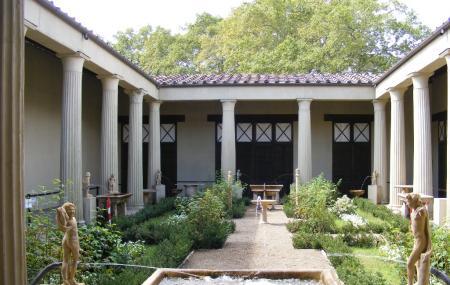
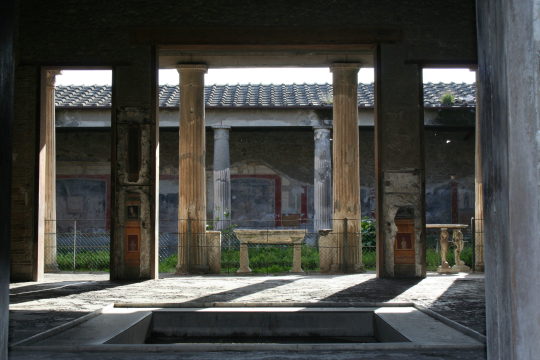

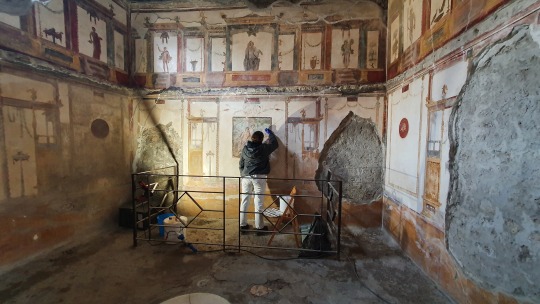

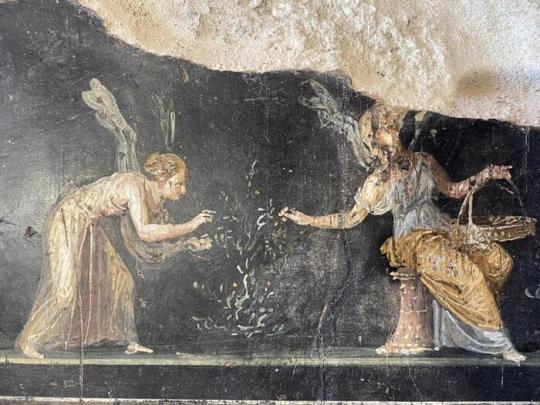

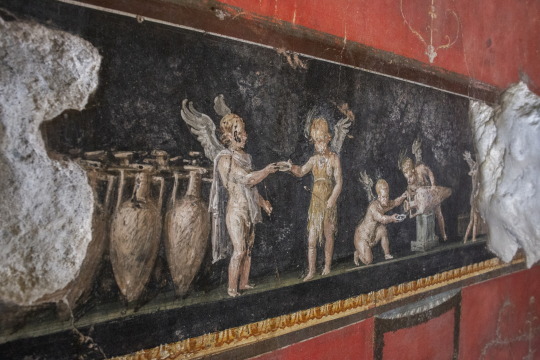
The House of the Vettii in Pompeii Reopens
The House of the Vettii, one of the largest and richest homes in Pompeii, prodigiously endowed with a fresco of Priapus that has become an icon of the city, reopens to the public on Tuesday after years of complex restoration.
The House of the Vettii was the home of Aulus Vettius Restitutus and Aulus Vettius Conviva, freedmen brothers who made a fortune as wine merchants and ascended the social ladder. Restitutus was a candidate for aedile, a magistrate responsible for holding public games and the maintenance of public buildings. Conviva was an Augustalis, a priest of the cult of the deified Augustus, a position of civic importance that was more akin to a magistracy. In this role he would have funded major public works projects.
The Vettii bought the house, originally built in the 2nd century B.C., after the earthquake of 62 A.D. It was in a tony neighborhood that many of the wealthy homeowners had left rather than rebuild. When the rich moved out, the nouveau-riche moved in. Freedmen who had made big bucks in trade like the Vettii were a prime example of the trend. They bought the aristocratic villa, repaired it and expanded it, adding a huge peristyle garden with statues and fountains. Every room was lavishly painted with frescoes on mythological motifs, telegraphing their wealth and the new status it bought them. Priapus, his massive phallus balancing on a scale against a bag of money, welcomed visitors in the vestibule of the house. Two large bronze strongboxes were placed in the atrium so everyone who got past Priapus would be confronted with the the most literal possible representation of the wealth of the Vettii.
The frescoes are mostly in the Pompeiian Fourth style, a combination of the previous three styles (faux marble veneers from the first, architectural trompe l’oeil from the second, ornate, stylized ornament from the third). The Vettii frescoes provide unique insight into the transition between the Third and Fourth style of mural painting. There is also a remarkable series of striking black and red frescoes depicting groups of cupids performing a variety of tasks, mythological ones like celebrating a festival of Bacchus and a festival of Vesta, sure, but of particular note are the representations of daily work, including the gathering and pressing of grapes, buying and selling the wine, dyeing and cleaning clothes in a fullery, picking flowers and making garlands for sale, making perfumed oil and making coins. The cupids are also captured at leisure, hunting on goat-back, racing in chariots pulled by deer and taking part in an archery contest.
The room adjacent to the kitchen was painted with a series of explicit erotic frescoes. It may have been a visual menu of options offered by an enslaved prostitute Eutychis who advertises her services for two asses (plural of as, the lowest-value Roman coin) on a graffito at the entrance of the house.
The domus was first excavated between late 1894 and early 1896. In the 1950s reinforced concrete roofs were added to the peristyle to protect the architectural remains from the elements. It was no longer protecting it, however. On the contrary, the flat concrete roof was unsound and directly contributing to water infiltration and damage.
Already affected by works in 1995, when the problem created by the concrete roofs of the 50s was evident, the house was partially reopened in 2016, after 12 years of closure and then closed again after 3 years for further restoration. Interventions that involved the roofing but also the paintings, with the removal of the patina created by previous restorations.
The old concrete roofs have now been replaced with sloped roofs formed from hollow blocks on metal frameworks. The wooden roofs added in the 1990s are still functional but needed refurbishment, and a new rainwater drainage system was devised to integrate the new roofs with the existing drainage system.
Conservators also cleaned and conserved the wall and floor decorations and the fixtures of the garden. It was a painstaking process of cleaning, regrouting and integrating interventions from different periods with the aim of recovering the legibility of the images and colors.
#The House of the Vettii in Pompeii Reopens#fresco of priapus#pompeii fresco#ancient artifacts#ancient art#archeology#archeolgst#history#history news#ancient history#ancient culture#ancient civilizations#roman empire#roman history#roman art
297 notes
·
View notes
Text

Fresco of Priapus, Casa dei Vettii, Pompeii. Depicted weighing his enormous erect penis against a bag of gold.
37 notes
·
View notes
Text


The Priapus in the House of the Vetii, Pompeii.
#ancient rome#ancientprettythings#original photography#ancient art#fresco#ancient fresco#priapus#house of the vetii#pompeii
94 notes
·
View notes
Text
This is great news. What an interesting house!
30 notes
·
View notes
Note
What are some correspondences for Priapus? Herbs, crystals, incense, etc.
Most of the historical associations we know about come from latin poetry, or as isolated epigrams (especially in the Palatine Anthology). Here are a few relevant excerpts:
Turning along this path here, goatherd, you will find a newly carved figwood statue, three-limbed, bark-bearing, and earless, but able with its child-begetting phallus to achieve the works of Cypris. A sacred enclosure runs round it, and an ever-flowing stream splashes from the rocks on all sides onto the laurels and myrtles and fragrant cypress; there the grape, child of the cluster, spills down from the tendril, and the spring jackdaws echo in high-pitched songs the variety of their warbling melodies, to which fair nightingales reply with trills, uttering the sweet sound from their beaks. (Theocritus. Epigrams. 4.9; AP 437.1–12)
Let gardens breathing with crocus flowers invite the bees, and may the guardianship of Hellespontine Priapus, protector against thieves and birds with his sickle of willow, protect it, while the master brings thyme and pine saplings from the high mountains and sows them widely around the bees’ dwelling. (Virgil, Georgics, l. 109-115)
Columella also says this regarding to the rocket/arugula: "which is sown next to fruitful Priapus to arouse sluggish husbands to love-making" (De Re Rustica 10.119–20)
Poem 51 of the Priapeia* also lists a fair amount of garden produce (figs, grapes, apple, pears, plums, sorbs, mulberries, almonds, cabbages, beet, leeks, cucumbers, gourds, basil, lettuce, onions, garlic, rocket, mint, rue) but the comedy in this poem comes from the fact that the neighbor's garden also has all these things, and therefore the thieves choosing to rob the garden Priapus guards must enjoy the (sexual) punishment he reserves for them. So it is difficult, in this context, to really say that these produce hold more "sacred" value to Priapus unless attested elsewhere (such as the figs, grapes or apples).
Priapus is, perhaps more than most, a god of the simple things, and considering his function has protector of the garden, it'd be simpler to say that all that grows in a garden is sacred to him.
This aside, in Roman literature, Priapus is a wooden god. His statue is rarely described as made of stone or marble because he is a practical guardian who would be crafted by the farmer. Most times, the essence isn't disclosed but some wood essences have been recorded*:
Fig wood (3 mentions)
Cypress (2 mentions)
Willow (2 mentions)
Poplar (2 mentions)
Oak (1 mentions)
Apple (1 mentions)
He is also often pictured near or underneath trees, both on frescos or on engraved gems, which is thought to be because that would be a common placement for his - often simple - altar.
I do not know of any historical mentions concerning incense choice. He is not present in the Orphic Hymns (at least not without syncretism). And when it comes to crystals, there does not seem to be a specific pattern concerning the gem choice on which he is engraved outside of already very popular gem choices. On the topic of gemstones, I'd recommend giving this post a read where I explain how the ancient's conception of crystal associations and uses tends to be very different from how we understand it today.
*Priapeia poems, 51
**Sageaux, Laura. "La statue en bois du dieu Priape en contexte champêtre." Journée d'Études des doctorants CRATA-ERASME: Pouvoir et Religion dans l’Antiquité: échos, mémoire, oubli. 2018.
13 notes
·
View notes
Text
Community Guidelines_Censorship
When I first set up this Blog on the Hypnerotomachia Poliphili I devoted an extended section looking at Francesca Colonna's OPUS in terms of the Book as (1) Romantic Epic_and (2) an Erotic Epic _Treatise . Tumblr have ruled that the Section on the Erotic aspects of the Hypnerotomachia are not "in synch" with Community Guidelines and_for that reason _cannot be displayed to the Public (tho I retain the Blog for "myself only").This is somewhat sad given that all the illustrations of Works of Art derive from municipal Museums that are open to the Public.It's just a fact of life that if you go into any Museum in England or on the Continent you will be bombarded with Works of Art of a highly Erotic_Sexual nature but if you transfer these images to an alternate platform for purposes of "social networking" on the Web these images are deemed inappropriate .On the whole the pictorial images related to "artifacts" in the (former) Museum of the King of Naples OR from the archeological excavations at Pompeii.The purpose of the BLOG was to look at these images(of Herms,phallic tintinibullum,on stonecarvings,wall plaques,pottery,vases,frescoes depicting satyrs,maeneads,the Aegean Silenus,Priapus,polyphallic Mercury etc)within the context of the Era_within the "Weltanshuang"_World View of the Ancient Graeco_Roman World and to demonstrate that they were "ubiquitous" images found "everywhere"..and that within the Ancient World the people were not so "hung-up"about Sex as we are in the Modern World . Having said that these images do _to some degree_ demonstrate the male domineering ethos of the times ..Chauvinism +Mysogyny...but that was simply an aspect of the Ancient World & no Historian can escape examining these matters if he_she wants to get an objective view of Daily Life in those days . Having said that I'm not contesting the ruling of Tumblr in this case. However it is at times very tedious to spend time finely tuning a presentation on the Web .Years ago I presented a page on the Hypnerotomachia Poliphili on MySpace and later one on Facebook .Both pages attracted numerous "Friends" tho few were prepared to "engage" beyond the occasional "Text" _something that sums up our MobilePhone orientated Society in a Nutshell _Both MySpace & Facebook banned "Naked Imagery" so 100s of Images depicting scenes from Greek Mythology had to be erased subjecting the entire exercise to serious abasement _for example _the deletion of hundreds of images of "The Three Graces"..."Leda & the Swan".."TheStartled Nymph and Satyr"_many of which are quite "tame".
Below .Leonardo da Vinci_ Renaissance Pornography_ Leda & the Swan x2
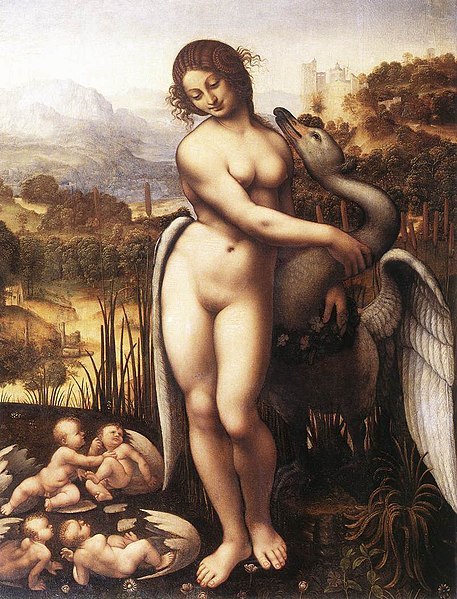
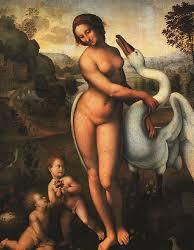
Below "Nymph and Sleeping Satyr"_for variety (Usually it's the other way around_"The Sleeping Nymph and Satyr")
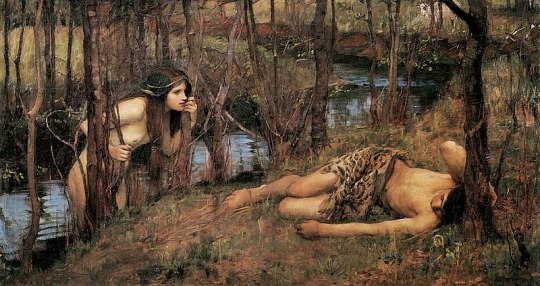
Below >The Three Graces from Botticelli's "Primavera"
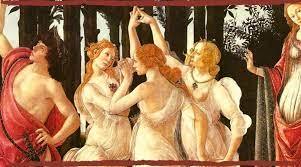
Below "The Three Graces" with clothes on

Below _Raphael's "Three Graces"
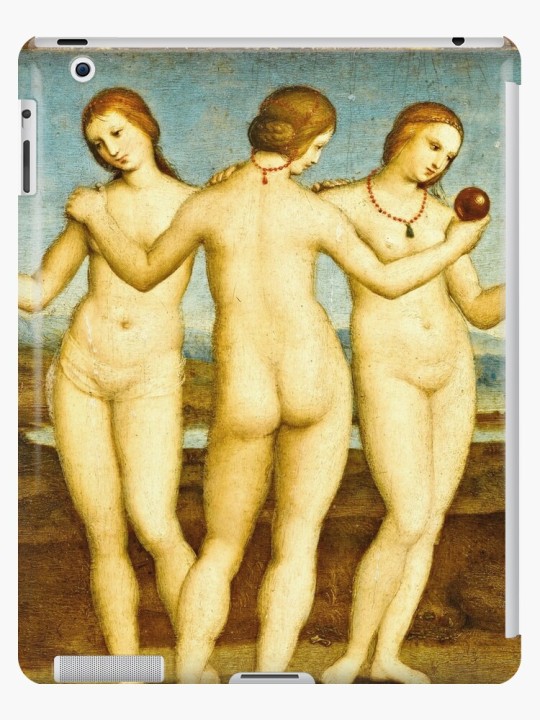
Greek Statue of "The Three Graces"
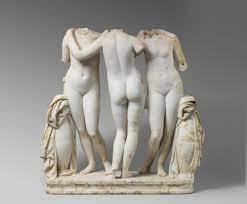
Canova's "The Three Graces"

Below .Edgar Wind _"Pagan Mysteries of the Renaissance"..contains detailed analysis of Renaissance Humanist Pico della Mirandola's Heart Medallion embossed with image of the Three Graces . Dr_Professor Wind explains symbolism of the ThreeGraces as GIVING>>RECEIVING>>RECIPROCATING _the "Highest Teaching_Highest Wisdom of the Ancient Graeco-Roman World .
..............................................................................................................................
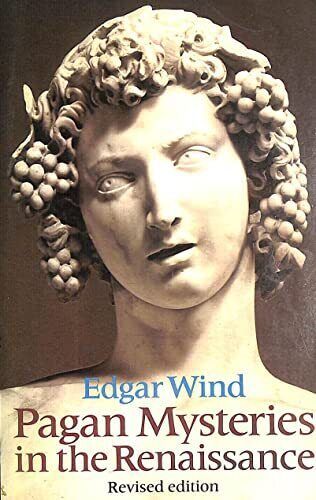
The Censorship of my Blog also erased a short section on the PRONUNCIATION of the words Hypnerotomachia Poliphili...as well as a Section on the Hypnerotomachia as a Romantic Epic .
0 notes
Text

// Today in weird and sorta fucked up mythology, I'm going to relate to you a story that makes me wonder who the fuck told it first.
Once upon a time in Ancient Greece, Dionysus decided to give a donkey human speech. Why? Because reasons.
The donkey then decides to challenge the god Priapus to a debate over who has the superior penis. For clarification, Priapus is a god of animal and plant fertility, and he's usually depicted with a dick as long as his arm and about six inches wide.
I didn't make that up, they did that, you can look it up for yourself. They painted frescos and made statues of the guy. Because of course they did.
Anyway!
The donkey, unsurprisingly, loses the debate about who has the best dick to the god who is about 1/3rd penis. Priapus then kills the donkey, and Dionysus decides to make it into a constellation. Why? I have no idea.
That's the fun thing about mythology, sometimes the stories make no sense and yet you're like 'well, I can't exactly claim we as humans have changed much given the fanfiction we write.'
0 notes
Text
the priapus fresco on pompeii has truly lived in my mind rent free for five years now
1 note
·
View note
Photo

Revealing the Risqué Art of Pompeii’s House of the Vettii
The House of the Vettii is one of the most important and spectacular sites in Pompeii. Its nearly 12,000 square feet are replete with bronze and marble sculptures, and its courtyard garden once boasted 12 spurting fountains—all of them stilled by the volcanic eruption that buried the city in 79. Elaborate frescoes adorning the mansion’s walls, which depict characters and stories from mythology, have elicited careful study by archeologists, classicists and historians since the site’s excavation in the mid 1890s. And this year, after a restoration that took two decades, its treasures are newly accessible to the public, in all their colorful detail. And we do mean colorful: Take the portrait of Priapus, the god of fertility, whose tumescent member is roughly the size of his forearm. In an apparently boastful display, he weighs it with a handheld scale against a bag of coins. Peek at the fresco of a man and woman in flagrante delicto on the wall of a small room that was used as the cook’s bedroom—or perhaps, some scholars argue, as a small brothel. What seems titillating to us, however, was a little more prosaic to the Romans. “It really shocks people when they see images of lovemaking on the walls,” notes Steven Tuck, a classics professor at Miami University of Ohio, who drew heavily from the House of the Vettii for his popular textbook, A History of Roman Art. “It forces us to realize that these people are not just people like us wearing togas. They have a completely different set of cultural values.” The specific Romans who inhabited the House of the Vettii were Aulus Vettius Restitutus and Aulus Vettius Conviva, wine merchants who made their fortunes after being freed from slavery. (Though they’re often called “brothers,” it is unknown whether they were related by blood, or simply grew up as slaves in the same household.) Their path to prosperity was not an uncommon one—the House of the Vettii dates to a time when a self-made aristocracy, including many former slaves, was growing in Pompeii. “It was certainly true that you could have an absolutely hideous life as a slave,” says David Potter, a professor of Greek and Roman history at the University of Michigan, “but there’s also a major path of social advancement, because slaves are educated in a rich person’s house.” The Vettii, who like many Roman slaves would have been freed in their early 20s, likely lived here with their wives and families, Potter says. In Roman society, women and men socialized in the same spaces, and both genders would have experienced erotic paintings and sculptures as conversation pieces perfectly fit for polite company. Priapus symbolized male power and virility, but he was also the enemy of thieves, as well as a humorous figure that might have made guests smile. “What you’re saying with this picture is, ‘Priapus looks after us because we’ve made a lot of money,’” Potter says. “But with the scale, it’s also a natural joke.” Erotic art has been turning up at Pompeii since excavations began in the 18th century. At first, the naughtier pieces would be spirited off to the Gabinetto Segreto (Secret Cabinet) in Naples, away from the innocent eyes of the general public. The House of Vettii, however, was one of the first sites to be unearthed using modern archeological techniques, and its artifacts were left in situ so their context could be preserved for future scholars and the public. Which doesn’t mean the Victorian-era archeologists weren’t still scandalized by what they found. According to an 1896 edition of The English Illustrated Magazine, a House of the Vettii painting “only suitable to that barbarous period of Europe’s history [was] very properly… covered over” before the dig continued. In addition to being a little prudish, Pompeii’s early caretakers also made some well-intentioned mistakes. To protect frescoes from the region’s heat and humidity, they painted on a solution of wax and benzine, which oxidized the pigments over time, darkening the colors and making the images far less crisp and lively than they would have appeared on the eve of the eruption. “The wax had two effects,” says Tuck. “One is that everything looks muddy, like you’re looking at it through a scratched piece of Plexiglas. There’s volcanic dust all over Pompeii still, and it sticks to the surface of the wax and makes the paintings much harder to see.” The other problem, he explains, is less obvious but more serious: Wax doesn’t expand and contract with changes of temperature in the same way plaster does, and over time that material conflict caused cracks in the walls. Technology, however, has come a long way. The recent restoration of the House of the Vettii involved the painstaking removal of all that dirt and wax using lasers, a process called photoablation. Ultrasound and thermal imaging helped conservators understand how the walls themselves were deteriorating with time, and how to shore them up without damaging the frescoes. The payoff, by all accounts, was worth the effort. “The colors, the clarity—it was really wonderful,” says Tuck, who toured some of the restored rooms. Potter, whose research has taken him to Pompeii many times, is already planning another trip, not only to see the restored House of Vettii—and Priapus in all his newly visible glory—but also to commune with the Romans through what is still the best medium we have for understanding this lost civilization. “This work to reconstruct the city is really important,” he says, “because it lets you feel how people lived shoulder to shoulder. Here, you can really be in touch with the ancient world.”
https://www.atlasobscura.com/articles/art-pompeii-house-of-the-vettii
0 notes
Text
Although the excavation of Pompeii was initially an Enlightenment project, once artifacts were classified through a new method of taxonomy, those deemed obscene and unsuitable for the general public were termed pornography and in 1821[1] they were locked away in a Secret Museum. The doorway was bricked up in 1849.[2] Throughout ancient Pompeii and Herculaneum, erotic frescoes, depictions of the god Priapus, sexually explicit symbols and inscriptions, and household items such as phallic oil lamps were found. The ancient Roman understanding of sexuality viewed explicit material very differently from most present-day cultures.[a] Ideas about obscenity developed from the 18th century to the present day into a modern concept of pornography.[3]
At Pompeii, locked metal cabinets were constructed over erotic frescos, which could be shown, for an additional fee, to gentlemen but not to ladies. This peep show was still in operation at Pompeii in the 1960s.[4] The cabinet was only accessible to "people of mature age and respected morals", which in practice meant only educated men.
So basically, the Romans built a bunch of porn, none of the porn made it to the present day... except in Pompeii and when they dug it up, it was uh... woops?
So basically, Rome the TV show was pretty accurate.
1 note
·
View note
Video

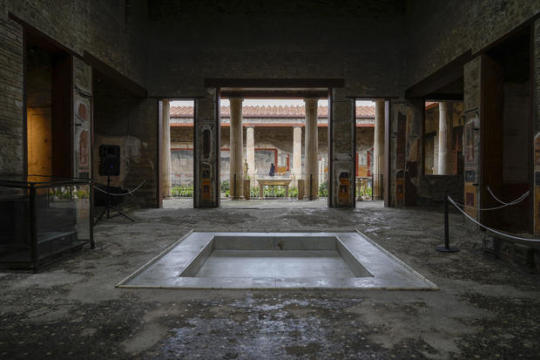
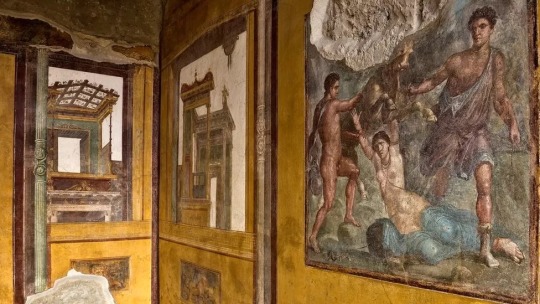

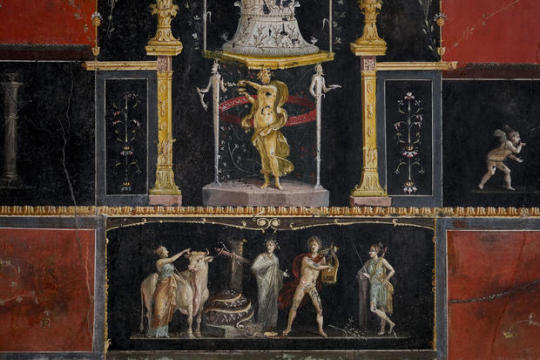
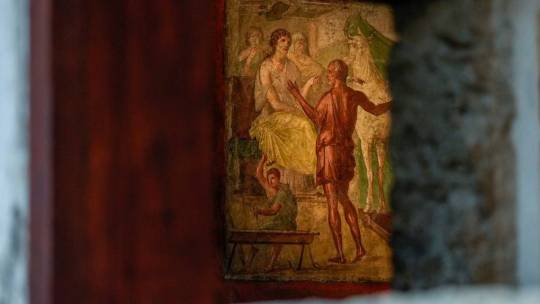
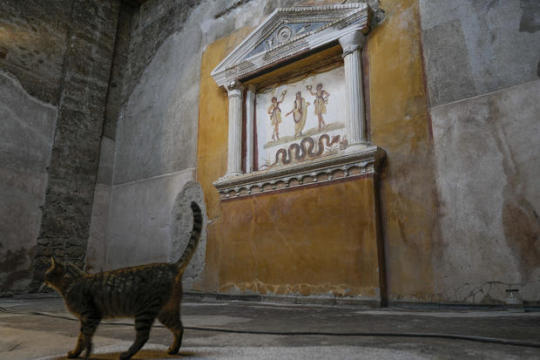




House of the Vettii
Pompeii home owned by former slaves reopens.
The House of the Vettii, known as Pompeii's Sistine Chapel, has reopened to the public for the first time in 20 years after an extensive restoration.
The house, built in the second century BC, was buried in the eruption of Mount Vesuvius in AD79.
It was named after its owners, the Vettii brothers, two former slaves.
Aulus Vettius Conviva and Aulus Vettius Restitutus got wealthy by selling wine after they were freed.
Adorned in mythological frescos and phallic sculptures, the house reopened on Tuesday after years of restoration work.
Excavation works carried out between late 1894 and early 1896 showed that the ancient Roman townhouse, built on top of the ruins of an earlier house, had survived the eruption of Mount Vesuvius.
"The owners, freedmen and ex-slaves, are the expression of a social mobility that would have been unthinkable two centuries earlier," said Gabriel Zuchtriegel, director of the Archaeological Park of Pompeii.
He added that the brothers became rich by trading agricultural products from the surrounding area in Pompeii - but added that prostitution was also practiced in their house.
In the house, the Greek god of fertility and abundance, Priapus, is depicted in a fresco weighing his own phallus against a bag of money.
Ornate furnishings inside the house, as well as Greek and Roman sculptures in bronze and marble, offer a glimpse into the lifestyle of the elite.
#Pompeii#Pompeii's Sistine Chapel#The House of the Vettii#Mount Vesuvius#Aulus Vettius Conviva#Aulus Vettius Restitutus#Priapus#frescos#mosaics#ancient artifacts#archeology#archeolgst#history#history news#ancient history#ancient culture#ancient civilizations#roman history#roman empire#roman art
629 notes
·
View notes
Text
"Buddies"
Located in the ancient city’s wealthy quarter, the sprawling House of the Vettii was owned by Aulus Vettius Restitutus and Aulus Vettius Conviva, who became rich by selling wine after being freed from slavery.
Theories in the past have suggested that the two men were brothers, but it is more likely that they met when enslaved and had the same master, whose name was Aulus Vettius, according to Gabriel Zuchtriegel, the director of Pompeii archaeological park.
“If they were from the same family the first two names would have been different and they would have the same surname,” he said. “It was uncommon to have biological siblings who were slaves and then set free, because family ties were cut with slavery so it’s very unlikely they were brothers. It’s more likely that they were buddies during their time as slaves and then set free.”
#lgbt history#queer history#ancient rome#79 ad#lgbt#queer#lgbqti#aulus vettius restitutus#aulus vettius conviva#gay#mount vesuvius#ancient pompeii#house of the vettii#archaeology#mt vesuvius#pompeii
262 notes
·
View notes
Photo

Priapus. Fresco in the House of The Vettii, Pompeii.
Priapus was a minor god of fertility; His phallus symbolized the fertilizing force of Nature; That is why in this fresco he is represented weighing his erect phallus against the bag of earnings, and at his feet a basket with different fruits and vegetables.
Ancient Romans used to have statues and paintings of Priapus in their home to bless and protect their private gardens; It has nothing to do with sexuality or masculinity, as I have heard it said. The famous phallic figures that can be seen everywhere in Pompeii were powerful talismans to attract abundance and protection in the harvests.
Photo by Sailko, CC BY-SA 4.0 via Wikimedia Commons.
Casa dei vettii, vestibolo, priapo che poggia il fallo sulla bilancia.
336 notes
·
View notes
Text
i gave out a pack of erotic pompeian art playing cards as my white elephant gift at a teacher potluck today, and the look on everyone's faces when they saw the priapus weighing his dick fresco was so, so worth it
232 notes
·
View notes
Text
Notes on a Theme...

Jean-Honoré Fragonard, The Progress of Love: Reverie, 1772.

Constantin Brancusi, Princess X, 1916.
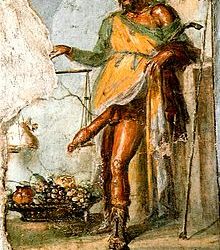
Fresco of Priapus, House of the Vettii, Pompeii, c. 79 AD
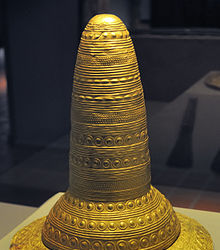

The Golden Hats, c. 1000 BC
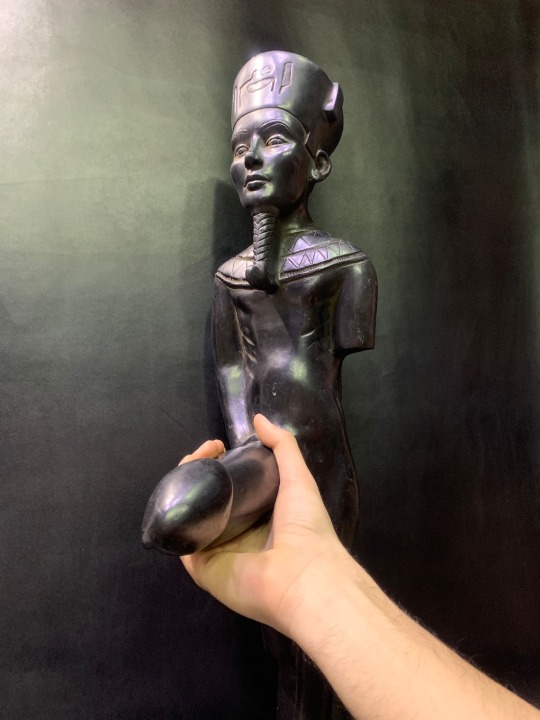
Etsy product claiming to be a replica of Ancient Egyptian depictions of the god Min, 2021.
#constantin brancusi#princess x#Jean-Honoré Fragonard#priapus#the golden hats#min#ancient egypt#etsy#phallus
11 notes
·
View notes